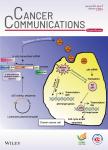The ongoing trends of patient-derived xenograft models in oncology
作者机构:Department of Hepatobiliary and Pancreatic SurgeryAffiliated Hangzhou First People’s HospitalZhejiang University School of MedicineHangzhouZhejiang 310003P.R.China Department of Hepatobiliary and Pancreatic SurgeryFirst Affiliated HospitalZhejiang University School of MedicineHangzhouZhejiang 310003P.R.China National Health Commission Key Laboratory of Combined Multi-organ TransplantationInstitute of Organ TransplantationZhejiang UniversityHangzhouZhejiang 310003P.R.China Department of Hepatobiliary and Pancreatic SurgeryLi Shui HospitalZhejiang University School of MedicineLishuiZhejiang 323000P.R.China
出 版 物:《Cancer Communications》 (癌症通讯(英文))
年 卷 期:2020年第40卷第11期
页 面:559-563页
核心收录:
学科分类:1002[医学-临床医学] 100214[医学-肿瘤学] 10[医学]
基 金:This work was funded by grants from the National Science and Technology Major Project of China(2017ZX10203205) the National Natural Science Funds for Distinguished Young Scholar of China(81625003) the Key Research&Development Plan of Zhejiang Province(2019C03050) the National Natural Science Foundation of China(81702858)
主 题:clinical specialized implantation
摘 要:1 MAIN TEXT Patient-derived xenograft(PDX)models have garnered increasing attention since the last *** models are typically characterized by the implantation of fresh patient-derived tumor tissues into immunodeficient *** models are well recognized in academic laboratories,pharmaceutical institutions,and specialized commercial organizations as having the ability to recapitulate genomics,transcriptomics,proteomics,and metabolomics of the parental tumor tissue[1,2].Recently,these models have been successfully used in preclinical studies to identify potential biomarkers for drug response and resistance,and to measure tumor evolution in response to treatment[3,4].Favorable outcomes demonstrated using PDX models could be used as ideal models for preclinical research and clinical translation studies.



